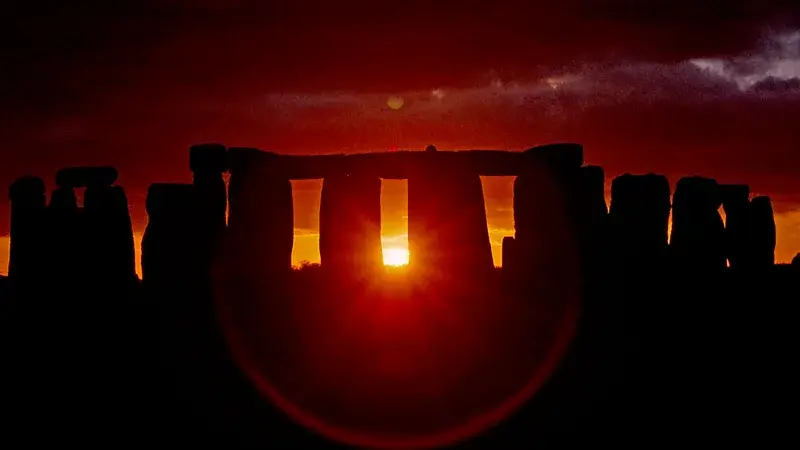Vithanage Erandi Kawshalya Madhushani Jade Times Staff
V.E.K. Madhushani is a Jadetimes news reporter covering Innovation.

Uncovering the Lost Stones of Stonehenge
Approximately 4,500 years ago, Stonehenge’s iconic silhouette looked very different from what we see today. Archaeologists and historians have long been captivated by its mysteries, particularly the fate of its missing megaliths. Why were some of these stones removed? Who took them, and where did they go? Through centuries of research, excavation, and advanced geological techniques, we are closer than ever to solving one of history’s great puzzles.
A Solstice Spectacle Like No Other
On the winter solstice, Stonehenge provides a mesmerizing spectacle. As the Sun sets, its light aligns perfectly with the towering Heel Stone and the central stone circle, casting an otherworldly glow through the structure’s gaps. Today, only remnants of this once-grand design remain, with several stones missing or relocated. For instance, Stone 56, the tallest and most intricately carved of the remaining megaliths, still bears a projecting bulge that once fit into a now-absent horizontal lintel.
Archaeological evidence suggests that up to six additional pairs of upright stones once marked this solstice alignment. These missing megaliths would have made the ancient solstice experience even more striking than it is today.
A Long History of Change and Restoration
The Stonehenge we see today reflects centuries of change and human intervention. The first accurate plan of the site, created in 1740, depicted the monument as it had existed for centuries. However, between 1901 and 1964, engineers realigned and reinforced many stones due to fears they might collapse. These efforts aimed to preserve the monument as it appeared in historical records, but archaeological excavations conducted alongside the restorations revealed evidence of a much more complex past.
Earlier records, such as those by John Aubrey in 1666, hinted that many stones were already missing. Aubrey identified five "cavities" near the circular ditch surrounding Stonehenge, suggesting the existence of an outer stone circle that has since vanished. Excavations in the 1920s uncovered 56 pits, now known as the Aubrey Holes, forming a perfect circle. While initially thought to have held wooden posts, some researchers now believe these pits once supported smaller stones.

The Missing Stones: Relocated, Destroyed, or Repurposed?
Excavations in the mid-20th century unearthed more evidence of missing stones, including pits indicating the removal or rearrangement of megaliths. In 1979, archaeologists discovered a pit near the Heel Stone, revealing that another large stone once stood there. Together, these stones likely framed the rising midsummer Sun in a striking solstice alignment.
Theories about the fate of these missing stones abound. Some may have been deliberately broken up and removed. For instance, the fallen Slaughter Stone bears marks of hammer and chisel work, as if interrupted during an attempt to extract a piece. Others may have been relocated to form new structures or circles nearby.
In 2009, archaeologists discovered a previously unknown stone circle near Stonehenge. This circle, marked by 25 empty pits, suggests that smaller "bluestones" from this site may have been transported to Stonehenge itself.
The Legacy of Looting and Weathering
Over the centuries, Stonehenge has suffered extensive damage from both natural erosion and human activity. In the 19th century, visitors reportedly hired hammers to chip off souvenirs. A 2012 laser survey revealed the extent of this damage, with some fallen stones resembling "sausage rolls" due to the significant material lost to chiseling.
The monument’s smaller bluestones, composed of softer rock, have fared worse than the larger sarsens. Many survive only as stumps or scattered debris, with evidence suggesting some were broken up as early as Roman times. Local folklore even attributes healing properties to fragments of these stones, potentially explaining their removal.
Tracking the Stones’ Origins
Advances in geology have provided remarkable insights into Stonehenge’s construction. The larger sarsens, made of resilient sandstone, are believed to have been sourced locally. In contrast, the bluestones originated from much farther afield, primarily southwest Wales.
One exception is the Altar Stone, a unique sandstone bluestone previously thought to have come from South Wales. Recent studies using cutting-edge technology traced its origins to northeast Scotland, making it the most-traveled megalith at Stonehenge. This discovery, achieved through analysis of tiny fragments, underscores the monumental effort required to transport these stones to Salisbury Plain.
Stonehenge’s Enigmatic Evolution
Stonehenge’s story is one of constant transformation. While many questions about its original design and purpose remain unanswered, ongoing research continues to reveal fascinating details. From solstice alignments to the relocation of stones, each discovery adds a new layer to our understanding of this ancient wonder.
For archaeologists, the mystery of Stonehenge’s missing megaliths serves as a reminder that the past is never truly lost—it is waiting to be uncovered, one stone at a time.



































Comments